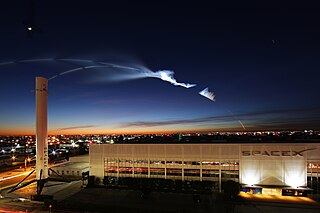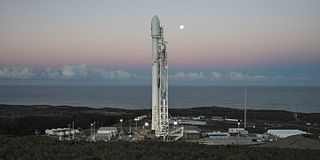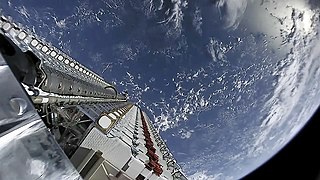
Space Exploration Technologies Corp., trading as SpaceX, is a private American aerospace manufacturer and space transportation services company headquartered in Hawthorne, California. It was founded in 2002 by Elon Musk with the goal of reducing space transportation costs to enable the colonization of Mars. SpaceX has developed several launch vehicles and the Dragon spacecraft.

Falcon 9 is a partially reusable two-stage-to-orbit medium lift launch vehicle designed and manufactured by SpaceX in the United States. It is powered by Merlin engines, also developed by SpaceX, burning cryogenic liquid oxygen and rocket-grade kerosene (RP-1) as propellants. Its name is derived from the Millennium Falcon and the nine engines of the rocket's first stage. The rocket evolved with versions v1.0 (2010–2013), v1.1 (2013–2016), v1.2 "Full Thrust" (2015–present), including the Block 5 Full Thrust variant, flying since May 2018. Unlike most rockets, which are expendable launch systems, since the introduction of the Full Thrust version, Falcon 9 is partially reusable, with the first stage capable of re-entering the atmosphere and landing back vertically after separating from the second stage. This feat was achieved for the first time on flight 20 with the v1.2 version in December 2015.

Space Launch Complex 4 (SLC-4) is a launch and landing site at Vandenberg Air Force Base with two pads, both of which are used by SpaceX for Falcon 9 launch operations; operating as Landing Zone 4 (LZ-4) for SpaceX landings.

The Falcon Heavy is a partially reusable super heavy-lift launch vehicle designed and manufactured by SpaceX. It is derived from the Falcon 9 vehicle and consists of a strengthened Falcon 9 first stage as the center core with two additional first stages as strap-on boosters. The Falcon Heavy has the highest payload capacity of any currently operational launch vehicle, the second-highest capacity of any rocket ever to reach orbit, trailing the Saturn V, and the third-highest capacity of any orbital-class rocket ever launched.

The SpaceX reusable launch system development program is a privately funded program to develop a set of new technologies for an orbital launch system that may be reused many times in a manner similar to the reusability of aircraft. SpaceX has been developing the technologies over several years to facilitate full and rapid reusability of space launch vehicles. The project's long-term objectives include returning a launch vehicle first stage to the launch site in minutes and to return a second stage to the launch pad following orbital realignment with the launch site and atmospheric reentry in up to 24 hours. SpaceX's long term goal is that both stages of their orbital launch vehicle will be designed to allow reuse a few hours after return.

Falcon 9 v1.1 was the second version of SpaceX's Falcon 9 orbital launch vehicle. The rocket was developed in 2011–2013, made its maiden launch in September 2013, and its final flight in January 2016. The Falcon 9 rocket was fully designed, manufactured, and operated by SpaceX. Following the second Commercial Resupply Services (CRS) launch, the initial version Falcon 9 v1.0 was retired from use and replaced by the v1.1 version.

The Falcon 9 first-stage landing tests were a series of controlled-descent flight tests conducted by SpaceX between 2013 and 2016. Since 2017, the first stage of Falcon 9 missions has been routinely landed if the rocket performance allowed it, and if SpaceX chose to recover the stage.

An autonomous spaceport drone ship (ASDS) is an ocean-going vessel derived from a deck barge, outfitted with station-keeping engines and a large landing platform and is controlled by an autonomous robot. Construction of such ships was commissioned by aerospace company SpaceX to allow for recovery of rocket first-stages at sea for missions which do not carry enough fuel to return to the launch site after boosting spacecraft onto an orbital or transplanetary trajectory.

Starlink is a satellite constellation being constructed by SpaceX to provide satellite Internet access. The constellation will consist of thousands of mass-produced small satellites in low Earth orbit (LEO), working in combination with ground transceivers. SpaceX also plans to sell some of the satellites for military, scientific, or exploratory purposes.

Falcon 9 flight 20 was a Falcon 9 space launch that occurred on 22 December 2015 at 01:29 UTC. It was the first time that the first stage of an orbital rocket made a successful return and vertical landing.

Falcon 9 Full Thrust is a partially reusable medium-lift launch vehicle, designed and manufactured by SpaceX. Designed in 2014–2015, Falcon 9 Full Thrust began launch operations in December 2015. As of 22 April 2020 Falcon 9 Full Thrust had performed 64 launches.
The SpaceX Starship is a fully-reusable launch vehicle and spacecraft that is being privately developed by SpaceX. It is designed to be a long-duration cargo and passenger-carrying spacecraft. The development of the Starship began in 2014.

The Falcon Heavy test flight was the first attempt by SpaceX to launch a Falcon Heavy rocket on February 6, 2018 at 20:45 UTC. The successful test introduced the Falcon Heavy as the most powerful rocket in operation, producing five million pounds-force (22 MN) of thrust and having more than twice the lift capacity of United Launch Alliance's Delta IV Heavy.

Paz is a Spanish Earth observation and reconnaissance satellite launched on 22 February 2018. It is Spain's first spy satellite. The satellite is operated by Hisdesat. Paz was previously referred to as SEOSAR.

Falcon 9 booster B1046 was a reusable Falcon 9 first-stage booster manufactured by SpaceX. It flew four times between 2018 and 2020 before breaking up during a successful abort test of the Crew Dragon. It was the first Block 5 upgrade to the Falcon 9.

The SpaceX Starship is planned to be a fully reusable launch vehicle. The vehicle is under development by SpaceX, as a self-funded private spaceflight project. While the Starship will be tested on its own initially at suborbital altitudes, it will be used on orbital launches with an additional booster stage, the Super Heavy, where Starship will serve as the second stage on a two-stage-to-orbit launch vehicle. The combination of spacecraft and booster is called Starship as well by SpaceX.

Falcon 9 Block 5 is a two-stage-to-orbit medium lift launch vehicle designed and manufactured by SpaceX in the United States. It is the fifth version of Falcon 9 Full Thrust. It is powered by Merlin engines, also developed by SpaceX, burning liquid oxygen (LOX) and rocket-grade kerosene (RP-1) propellants.

Falcon 9 booster B1056 was a reusable Falcon 9 Block 5 first-stage booster manufactured by SpaceX. The booster was the fourth Falcon 9 to fly four times and broke a turnaround record for an orbital class booster on its fourth flight. The booster's service came to an end on its fourth flight following a landing failure on a Starlink flight.






















